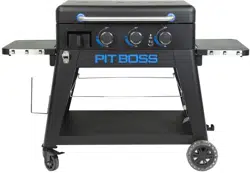Loading ...
Loading ...

ENGLISH
3
2. The liquefied petroleum (LP) cylinder must be constructed and marked in accordance with the specifications for LP Gas
Cylinders of the U.S. Department of Transportation (D.O.T.) or the National Standard of Canada, CAN/CSA-B339, Cylinders,
Spheres and Tubes for Transportation of Dangerous Goods; and Commission. The LP gas tank must have a shutoff valve,
terminating in an LP gas supply tank valve outlet, that is compatible with a Type 1 tank connection device. The LP gas tank
must also have a safety relief device that has a direct connection with the vapor space of the tank. The tank supply system
must be arranged for vapor withdraw. The LP gas tank used must have a collar to protect the tank valve.
3. You must use an OPD gas tank which offers an Overfill Prevention Device. This safety feature prevents the tank from being
overfilled which can cause malfunction of the LP gas tank, pressure regulator and/or grill.
4. This outdoor griddle is not intended for installation in/on recreation vehicles or boats.
Never use this appliance in an enclosed space, such as a camper, tent, car, boat or home. This appliance is
not intended for and should never be used as a heater.
5. This appliance is not recommended for children, persons with reduced physical, sensory or mental capabilities, or lack of
experience and knowledge, unless they are under direct supervision or instruction by a person responsible for their safety.
6. Parts of the barbecue may be very hot, and serious injury may occur. Keep young children and pets away while in use. Do
not touch hot surfaces. Use heat-resistant gloves, long-handled tongs, or cooking mitts at all times, since the griddle will
become very hot.
7. Never use the griddle without the grease cup installed and hung under the firebox. Without the grease cup, hot grease and
debris could leak downward and produce a fire hazard.
8. Do not obstruct the flow of combustion and ventilation air to this appliance. Keep the burner tube and portholes clean and
free from debris. Clean before use. Regular care and maintenance is required to prolong the lifespan of your unit.
9. Always check for gas leaks when you connect and disconnect the regulator to the gas cylinder, especially after a period of
storage (for example, over winter). Check all connections for leaks with a soapy water solution and brush. Never use an open
flame to check for leaks.
10. Clean and inspect the gas regulator before each use of the outdoor cooking gas appliance. Replace the gas regulator prior
to being used if there is evidence of excessive abrasion or wear. Use only the gas regulator assembly that has been supplied
with this gas griddle. Do not use a regulator from another manufacturer. The replacement hose assembly shall be that
specified by the manufacturer.
Do not use lava rock, wood chunks, charcoal, lighter fluid, alcohol or other similar chemicals for lighting or
relighting. Keep all such substances and liquidS WELL away from appliance when in use.
11. Operate this appliance using propane gas only, which is also specified on the rating label on the unit. Do not attempt to
operate your griddle on other gases. Do not attempt to convert this LP unit to natural gas. Failure to follow this warning
could lead to fire, bodily harm, and will void your warranty.
12. The location of the burner tube with respect to the orifice is vital for safe operation. Check to ensure the orifice is inside the
burner tube before using the gas grill. If the burner tube does not fit over the valve orifice, lighting the burner may cause
explosion and/or fire.
PROPANE GAS WARNINGS
1. Ensure the gas cylinder is purchased by a reputable supplier. An incorrectly filled or an overfilled LP gas cylinder can be
dangerous. The overfilled condition combined with the warming of the LP gas cylinder (a hot summer day, gas cylinder left
in the sun, etc.) can cause LP gas to be released since the temperature increase causes gas to expand. Gas released from the
cylinder is flammable and can be explosive.
2. Do not use an LP gas cylinder if it has a damaged valve or shows signs of dents, gouges, bulges, fire damage, corrosion,
leakage, excessive rust, or other forms of visual external damage; it may be hazardous and should be checked immediately
by a liquid propane supplier.
Loading ...
Loading ...
Loading ...
